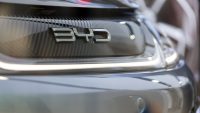 FIAT was in strife in the early 1980s. Not an unfamiliar situation for the Italian firm, in all fairness. But this particular predicament was especially bad.
FIAT was in strife in the early 1980s. Not an unfamiliar situation for the Italian firm, in all fairness. But this particular predicament was especially bad.
It needed a car to save it, to replace the ageing 127 and give the automotive giant the all-important volume it needs.
Basically, it needed a winner. A car that would sell in the millions, all around the world, that bulging factories could rush out day and night, and which would be different enough within a developing marketplace to ensure the buyers queued up with cash. It charged one Giorgetto Giugiaro, he of ItalDesign fame, to come up with an icon.
What he generated was a supermini template that even today defines how family cars look. Not bad. It was called the Uno, and was tall, boxy, had an aerodynamic squared-off tail, set passengers on high seats and sported flat, square lines throughout to realise maximum interior dimensions.
Launched in 1983, it became an instant modern classic. Up to then, we’d had Ford Fiestas and Renaults 5s defining the supermini sector.
Indeed, Fiat itself actually invented it, with the 1970s 127. But all these models basically reinterpreted larger cars – yes, they had a hatch, but they still stuck firmly to the ‘shrunken large car’ look of bigger machines.
The Uno adopted a completely different approach, using design from the inside out for, arguably, the first time since one A. Issigonis drew the original Mini. The results were startling, too – never before had a supermini had so much interior space and flexibility, felt so like a larger model, offered such an array of family-friendly layouts.
Rear legroom was vast; the boot could still be considered contemporary; seats were commanding enough to make up for the somewhat Italianate driving position. It was all set within a space-age, designer cockpit that, like the exterior, offered something completely fresh.
Out went your shrunken Ford Granada look, in came forward-looking instrument pods, with switches set around the steering wheel for operating by fingertips. The only column stalk was for the indicators, and it all worked brilliantly.
FIRE ENGINES
Fiat launched the Uno with a range of 127-derived engines, labelled by bhp – 45, 55, 65, 75 and 90. These were okay, but the 0.9-litre and 1.1-litre powerplants were also dated. Much better was the 1.0-litre FIRE engine that arrived in 1985. This used cutting-edge construction to match the modern design, and was extremely fuel efficient.
It made 1987’s rattly, noisy diesel a bit of an irrelevance. And also provided something of a contrast to the mid-1980s 1.3-litre whizz-bang turbo. 105bhp may not sound much today, but it was when packed into a car as light (and as hard-riding) as the Uno.
Continuing the clever theme, 1987 also saw the launch of an innovative CVT automatic variant, called Selecta. Inevitably, these were a bit unreliable, but they still set yet another template that brands such as Audi continue today. Shame, then, that Fiat lost some of this individuality when it facelifted the Uno for the 1990s.
Sure, the new interior rattled way less than the characterful original, but the identikit look was the exact opposite of the original’s approach. The styling was also toned down.
The 1984 Car of the Year eventually left Fiat new car dealer showrooms in 1995, after more than a quarter-million had been registered here. Indeed, total production topping six million means it most definitely deserves sales legend status. Particularly as, remarkably, it’s still being built over in Brazil, as the Fiat Mille.
It achieved its aims, and saved Fiat. Well, for long enough to prosper until the next crisis arrived (that needed the launch of the Punto to overcome). Seems oddly fitting, then, that one UK car magazine discovered the Uno was the 10th most scrapped car in the country. Yes, the model that saved dealers in the past is, courtesy of scrappage, still doing so today…
































